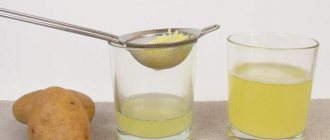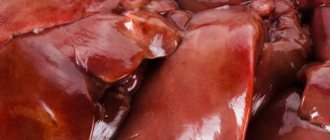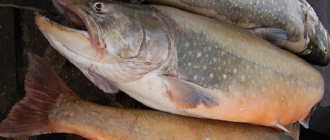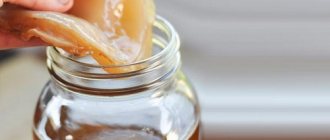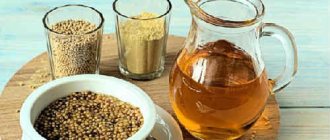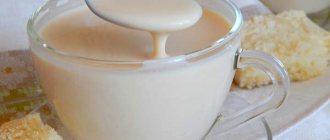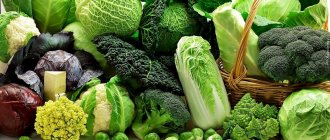Description of the plant
In everyday life, the names used for the vegetable are “petsai”, “salad cabbage” and the affectionate name “Pekingka”. Different varieties of Chinese cabbage form rosettes, with cylindrical or conical heads in the center.
The leaves have a white succulent petiole, wavy edges and a slightly pimply inside. The top of the head is usually green, the inside is yellow-green.
The vegetable has a delicate, subtle aroma, fresh, soft and crunchy taste.
Red Chinese cabbage is considered a novelty and has an attractive purple color on the outside and a beautiful internal structure.
Old and new varieties are profitable from a production point of view as early-ripening vegetables. Growing time is from 2 to 3 months. In warm climates, several harvests are obtained in open ground.
Application for weight loss
To lose weight, nutritionists recommend consuming the product fresh, eating at least 200 g daily. The satiety from cabbage remains for a long time, which significantly reduces the total daily calorie content. When preparing a diet, Chinese cabbage for weight loss is included in it very often.
Chemical composition and energy value
The leaves of the vegetable plant contain 16 types of essential amino acids, enzymes, macro- and microelements.
Chinese cabbage contains phosphorus, which is necessary for calcium metabolism, energy metabolism, and growth hormone activity.
Potassium, calcium, magnesium and iron are important for building bones and muscles, hematopoiesis, and maintaining water-salt balance.
Vitamins in Chinese cabbage are represented by ascorbic acid, beta-carotene, group B.
Contents of main ingredients per 100 g. raw product:
| Ingredient | Weight |
| Water | 95 g |
| Squirrels | 1.1 g |
| Fats | 0.3 g |
| Carbohydrates | 1.2 g |
| Vitamin C | 26 mg |
| Beta carotene | 425 mcg |
| Vitamin B1 | 0.03 mg |
| Vitamin B2 | 0.04 mg |
| Vitamin B6 | 0.12 mg |
| Folic acid | 65 mcg |
| Potassium | 140 mg |
| Calcium | 40 mg |
| Sodium | 20 mg |
| Phosphorus | 30 mg |
| Magnesium | 11 mg |
| Iron | 0.6 mg |
The calorie content of Chinese cabbage per 100 grams of raw product is from 12 to 16 kcal (about 52 kJ). Such low figures are not surprising: the vegetable consists of 95% water.
The glycemic index of Chinese cabbage is low - 32 units, so the product does not cause a sharp jump in blood sugar levels. Other indicators - the content of carbohydrates, cholesterol, sodium - are also low.
Losing weight with Chinese cabbage: benefits and harm to the body
Chinese salad consists of 95% water and is considered a product with “negative calorie content” - that is, the body spends more energy on its digestion than the kilocalories in itself. Therefore, the vegetable is recommended to be included in the diet of people who want to reduce body weight. Consumption of the product also helps speed up metabolic processes in the body, especially fat burning. At the same time, the fiber in the composition will gently cleanse the stomach and intestines.
The energy value of a leafy vegetable is only 16 kcal per 100 g, and the nutritional value indicators are given in the table:
| Squirrels | Fats | Carbohydrates |
| 1,2 | 0,2 | 2,0 |
At the same time, it is worth remembering that the cabbage mono-diet - eating only this product - will not bring benefits to the body due to a lack of fats and a deficiency of carbohydrates. It makes more sense to simply include cabbage in your diet in the form of salads, one of the snacks, or replacing part of the carbohydrate side dish with it.
It is enough to eat from 100 to 300 g of product per day to compensate for the lack of vitamins and microelements in the body. In addition, when eating cabbage, a false feeling of satiety occurs due to the combination of fiber and a set of microelements.
What are the benefits of Chinese cabbage?
Beijing contains mustard oil glycosides - glucosinolates. When the leaves are cut and chewed, a compound is released that has antibacterial properties.
The beneficial properties of Chinese cabbage are due to the composition of the yellow-green parts and white veins of the leaves. The vegetable's phytochemicals prevent certain types of cancer.
Advantages of eating and benefits of Chinese cabbage for the body:
- protects the stomach and intestines from ulcerative lesions;
- easily digestible and does not cause flatulence;
- dietary fiber helps digestion;
- strengthens the immune system.
Fiber in Beijing helps remove waste and toxins from the gastrointestinal tract. The protein component methylmethionine protects the gastrointestinal mucosa. One of the “secrets” of the product is its ability to cleanse the human digestive tract when consuming low-quality food.
Chinese cabbage has been successfully used for weight loss and maintaining optimal weight.
Frequent consumption of vegetables will help improve digestion and get rid of extra pounds. One of the properties of the product is called “negative calorie content”. The body requires more energy to digest than is contained in the vegetable itself.
Fresh Peking helps improve metabolic processes in the body. The product combines a favorable amino acid composition, vegetable proteins, vitamins and mineral elements. Eating it reduces the risk of deposits on the walls of blood vessels.
For the female body
Chinese salad is rich in iron, which the female body needs in increased quantities. This trace element reduces the likelihood of iron deficiency anemia.
Chinese cabbage is important for women as a product that has a beneficial effect on hematopoiesis. Beijing prevents the appearance of fatigue and feelings of drowsiness during the daytime.
Chinese cabbage is useful during pregnancy as a source of fiber, vitamins, macro- and microelements. Folic acid promotes the formation of red blood cells and prevents the appearance of defects in the unborn child. Before use, the vegetable is washed well and scalded with boiling water.
Chinese cabbage during breastfeeding is a controversial product, as it has pros and cons for mother and baby. Pediatricians do not recommend that a nursing woman consume overseas vegetables until the baby is 4 months old. The pickled product is completely excluded from the menu during breastfeeding.
How it will help men
Chinese cabbage is beneficial for men of all ages. Including this vegetable in the daily menu reduces the likelihood of developing an inflammatory process, including in the prostate gland.
Representatives of the stronger sex eat petsai to improve potency.
For children
All varieties of Pekinka contain vitamins C and B, which are necessary to strengthen the immune system. Peking cabbage is especially useful for children and adults in the cold season, when the body lacks vitamins.
The vegetable is used for a diet with a minimum amount of carbohydrates. The diet was developed at Harvard University for overweight children and adolescents.
Chinese cabbage - a sea of health benefits - video
Chinese cabbage contains very few calories, is easily absorbed by the body, restores the functioning of the digestive tract, helps to lose extra pounds, and improves the functioning of the genitourinary system in men and women. It has a good effect on the condition of the skin and hair.
It can be consumed with various vegetables, fruits and nuts. This valuable vegetable can be used to prepare both fresh salads and hot dishes. Ease of preparation and undeniable benefits for people of all ages indicate the importance of including Chinese cabbage in every person’s diet.
Contraindications for consumption
Fresh fruits, leaves, and roots often cause heaviness, pain in the upper abdomen, and heartburn. Raw Chinese cabbage is contraindicated for gastritis due to its high fiber content. The component irritates the mucous membrane of the stomach and duodenum.
Attention! A large amount of vegetables in the diet causes increased gas formation.
Other possible contraindications for Chinese cabbage:
- excessive sensitivity to certain ingredients;
- bleeding in the gastrointestinal tract;
- pancreatitis and enteritis.
Carefully! Consumption of this vegetable fresh is associated with the risk of infection with toxoplasmosis, the causative agent of which is present in water and soil.
The leaves and especially the succulent petioles may contain pesticides. The most likely presence of nitrates is used to quickly force vegetables.
Popular recipes
To ensure that the benefits and harms of a vegetable do not compete, it is important to learn how to properly prepare and eat it. Nutritionists agree that the ideal consumption option is to eat it fresh. Since this type has a delicate and unobtrusive taste, it can be combined with many products:
- carrots, all types of salads, cucumbers, tomatoes, beans, peas;
- with meat - boiled chicken or turkey sirloin, baked poultry breast, beef in the form of steaks, and so on;
- with boiled eggs, in the form of an omelet or fried egg.
Chinese cabbage contains only 15 kcal per 100 grams
It is noteworthy that a side dish of fresh Beijing partially neutralizes the harm that dishes made from fried vegetables, meat and fish have on the body. Therefore, if a person is on a low-calorie diet, you can make small indulgences in the form of steak or grilled meat, but serve as a side dish a large portion of Peking, sprinkled with balsamic vinegar and olive oil.
For weight loss, it is used in the form of casseroles, soups, and other hot dishes. It replaces regular white cabbage when preparing classic cabbage soup and borscht (you need to add the leaves to soups a couple of minutes before they are ready). Stuffed cabbage rolls stuffed with beans or beans, lean meat, and wrapped in pekin leaves have good taste.
For children over the age of two, the green beauty is served as a puree. Tender leaves are freed from veins and crushed with a blender. For a better taste, you can add a little cream and a pinch of salt to the puree.
Use for diseases
The usefulness of Chinese cabbage is higher in its raw form. For better absorption, a small amount of vegetable oil is added to the fresh vegetable.
Digestive diseases
Peking juice is drunk instead of tea when heartburn and nausea occur. The drink has an astringent effect and relieves inflammation.
Dishes for a patient with gastritis are prepared without spices; no salt, bay leaf, pepper, lemon juice or vinegar are added.
Peking cabbage for pancreatitis is allowed in small quantities from 3 weeks from the onset of exacerbation of the disease. The product is used for preparing first courses, served stewed or boiled. During the period of stable remission between periods of exacerbation, gradual introduction of fresh vegetables into the diet is allowed.
Joint inflammation
Chinese cabbage is allowed for gout as a therapeutic and prophylactic product. Consumed fresh, boiled and stewed.
The vegetable helps normalize metabolism and maintain the acid-base balance. Activates the removal of excess salts and uric acid compounds from the body, reduces the symptoms of gouty changes.
In folk medicine, in addition to eating pekinka, it is recommended to make compresses from the vegetable for inflamed joints. Apply fresh leaves to sore spots and secure with a bandage.
In China, petsai is considered a means of prolonging the youth of joints and the body as a whole.
Use for various diseases: beneficial properties and contraindications
Chinese cabbage has the following positive effects: cleanses the blood, helps remove toxins from the body, strengthens bones thanks to vitamin K, increases the immunity of the whole body, is a depressant, calms the nerves, lowers cholesterol, and has a diuretic effect. The juice will help with a hangover. A glass of freshly squeezed Chinese cabbage juice will help preserve your voice and strengthen your vocal cords. The benefits and harms of Chinese cabbage for the following diseases:
Diabetes
For people suffering from these diseases, any species of this plant will benefit. Protein and acids help control appetite, which will prevent you from gaining extra pounds. Cabbage juice removes cholesterol from the body. Since it has a low sugar and starch content, it can reduce the need for insulin.
Chinese cabbage for gastritis
If you have gastritis, eating Chinese cabbage raw is prohibited, as it can irritate the intestinal walls. Spices added to a dish during stewing can aggravate gastritis. When stewed, cabbage does not cause symptoms of gastritis, but you should remember that if this vegetable causes any discomfort, you should immediately stop consuming it, since everyone’s body is unique in its own way. However, cabbage juice has an astringent effect and acts as a sorbent, restores secretory function, and heals damaged areas.
Bloating
Eating large quantities of the vegetable can cause nausea, vomiting and diarrhea. And the combination with cheese and dairy products can cause bloating.
Gout
Cabbage can be eaten for gout and is even necessary; it removes excess fluid, toxins and salts, which is the main direction in the treatment of gout. Pathology develops due to the accumulation of salts and excess uric acid.
Chinese cabbage: harmful to the body
If you are taking blood thinning medications, you should limit your cabbage intake.
Citric acid, which is present in Chinese cabbage, will increase pain due to increased stomach acidity.
And the presence of lactic acid in large quantities causes irritation of the pancreas.
Can be used with caution by people with acute forms of colitis, enterocolitis, infectious or bacterial diarrhea, as well as bleeding in the stomach and intestines, with inflammatory processes in the liver and gall bladder
Chinese cabbage can lower blood pressure.
What to cook from Chinese cabbage
Before cutting Chinese cabbage, the product is thoroughly cleaned of outer leaves. Then the head of cabbage is cut lengthwise into several strips.
Recipes with Chinese cabbage are varied. For example, vegetable leaves are chopped, chopped radish roots and green onions are added. Sprinkle a light salad with apple cider vinegar. Season the dish with olive or sunflower oil.
Helpful Tips:
- Peking goes well with cucumbers, tomatoes, bell peppers, boiled eggs and various types of meat.
- To dress salads, light sauces, sour cream, olive or sunflower oil, and mayonnaise are used.
- Petsai is fried in a frying pan with oil, stewed, steamed for side dishes, and wrapped as a filling.
- The vegetable is good in soups, stews, casseroles and pies.
- Cabbage rolls from Chinese cabbage are prepared without boiling the leaves; the processing consists only of a short scalding with boiling water.
- The filling for the leaves can be any: meat, fish, vegetable, mushroom.
- The cooking time should be 5-6 minutes, otherwise the leaves will become soft and lose important ingredients.
Chicken salad
A delicious Chinese cabbage salad with chicken is prepared from coarsely chopped vegetables.
Ingredients:
- medium cabbage - 1;
- corn - 1 can;
- hard-boiled eggs - 3;
- chicken fillet - 1;
- mayonnaise.
Preparation:
- Finely chop the pekinka.
- Chop the eggs.
- Add corn and eggs to the cabbage.
- Boil the chicken fillet.
- Tear into fibers with your hands.
- Connect the components.
- Season with mayonnaise.
Traditional Asian cuisine dishes with Chinese cabbage are prepared from fermented, pickled or pickled vegetables.
Korean-style Beijing cabbage
The advantage of the preparation method is that the product is well stored under a layer of brine for up to a month.
Components:
- 1 Beijing;
- 12 teeth garlic;
- 12 pcs. chili pepper;
- 2 tbsp. l. salt;
- 3 pcs. allspice peas;
- 1 bay leaf;
- 1 l. water.
How to cook:
- Wash the cabbage.
- Cut into halves.
- Boil water, dissolve salt in it, cool.
- Place the Pekinka into a saucepan and add brine.
- Press down with a press and leave at room temperature for 10 hours.
- Wash and cut the chili pepper. Peel the garlic.
- Place 10 cloves of garlic, 12 chilies and 4 tbsp in a blender. l. brine.
- Beat until smooth.
- Remove the pekinka from the brine and squeeze it out.
- Wear gloves to prevent your hands from burning.
- Coat all the cabbage leaves with the pulp.
- Transfer to a container.
- Add black pepper, 2 cloves of garlic, bay leaf.
- Pour in some of the brine.
- Place in the refrigerator for 3 days.
Korean-style Beijing cabbage contains a lot of hot pepper and salt. It is not recommended to abuse this snack, especially if you have diseases of the gastrointestinal tract, heart and blood vessels.
How to marinate
Ingredients for cooking:
- Beijing - 1 kg;
- carrots - 200 gr.;
- garlic - 6 cloves;
- sunflower oil - 150 ml;
- salt - 1.5-2 tbsp. l.;
- vinegar - 100 ml;
- sugar - 2 tsp;
- coriander - 1 tsp.
How to cook:
- Remove outer leaves from Chinese cabbage.
- Cut into 4 parts.
- Chop coarsely.
- Grate the carrots on a Korean vegetable grater.
- Finely chop the garlic.
- Mix vegetables and coriander.
- Prepare the marinade from vegetable oil mixed with vinegar.
- Add sugar and salt.
- Warm up.
- Pour hot liquid over cooked vegetables.
- Mix everything.
- Let cool. Place in the refrigerator for 8 hours.
Chinese cabbage - harm
Despite the wide list of positive qualities, Peking tea can still pose a health risk. Citric acid is dangerous for people with high stomach acidity. It is contraindicated for those who suffer from various forms of gastritis, pancreatitis, colitis, and peptic ulcers. If there is a risk of gastrointestinal bleeding, it should also not be used.
It is highly undesirable to combine this vegetable with various dairy products. Cheeses, cottage cheese, milk sauces, and sour cream fall under this category. If you do not want to feel the full range of sensations from an upset stomach, then do not mix drinking Peking tea with dairy-containing foods.
And finally, it is worth mentioning that it is better to eat this cabbage grown by yourself or bought at the local market.
Do not forget that the benefits and harms of Chinese cabbage are a relative concept, so be careful when consuming it or introducing it into your diet. An acceptable amount for an adult is approximately 150 grams no more than 3 times a week, for children - no more than 100 grams.
About the benefits of Beijing for weight loss, video:
